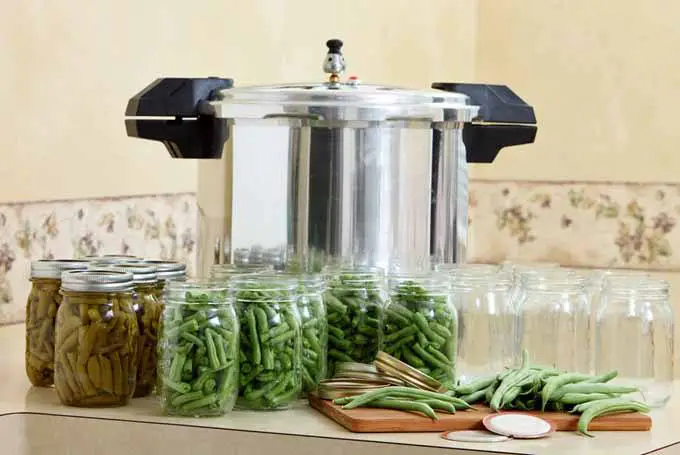Canning techniques rely on proper boiling temperatures and times, and a pressure canner altitude chart is a valuable tool in determining how long to process food in order to preserve and store it safely.
What is altitude?
Altitude is the height of an object or point in relation to sea level or ground level. Absolute altitude is the height from an object to the ground right below it, while true altitude is your height on the earth in comparison to sea level. Sea level has an altitude of 0. My true altitude where I live is 9100 feet above sea level. For canning, true altitude is the number that you need to pay attention to and refer to on the charts below.
How do I determine my altitude?
I live in the mountains and am always curious as to what the altitude is, so I downloaded a free App on my phone. Using GPS technology, it calculates the altitude of my exact location. The internet also has calculators where you can type in your city or zip code and it will show the altitude in your area. Check out myelevation.com to start with. If you can’t use these, call your state or county extension office and they should be able to provide you with this information. Altitude doesn’t change and you don’t need an exact number – just get a number in the ballpark to start with.
What is Air Pressure?

Pressure at sea level is 14.70 psi (pounds per square inch). This is the weight of the atmosphere pressing down on you. The higher above sea level you are, less air is pressing down upon you. At 10,000 feet, air pressure is 10.2 psi. There are charts and calculations available on the internet to find the exact air pressure at your altitude, but what you really need to know is that air pressure affects the boiling temperature of water.
What is the Boiling Temperature of Water?

Water boils at 212F or 100C at sea level. Let’s define boiling here as the point where the gas bubbles formed in water as it is heated burst. As you ascend higher in altitude, the air pressure is less, and this affects the temperature at which water boils. The air bubbles in the water burst at lower temperatures. At my altitude of 9,000 feet, water boils at 195F or 90.5C.
Why is this important to canning?
Safety of food preservation depends on sterilizing jars and processing food at the correct temperature. Botulism dies at 240F or 115.5C; therefore, it is important to get your foods up to this temperature. You can do this at sea level easily, but the higher in altitude, the more impossible it is to achieve this mark. In order to compensate for air pressure, you can boil water for a longer period of time, or process food in a pressure canner at a higher-pressure pound.
Boiling Water Canning Altitude Chart
If you are using the water bath canning method, here is a chart to follow.
If you are preserving at an altitude higher than 1,000 feet above sea level, adjust boiling water processing time as indicated.
| Altitude Feet | Increase Processing Time |
|---|---|
| 1,001 – 3,000 | 5 minutes |
| 3,001 – 6,000 | 10 minutes |
| 6,001 – 8,000 | 15 minutes |
| 8,001 – 10,000 | 20 minutes |
Boiling water bath canning relies on the high acidity of food and heat of the boiling water to preserve it. Given that the boiling point of water drops 2 degrees for every 1,000 foot in elevation gain, processing time is increased as your altitude rises. At my altitude of 9,000 feet, I would boil my canning jars for at least 20 minutes. It doesn’t hurt anything to boil it longer.
Pressure Canning Altitude Chart
On the other hand, pressure canners rely on the build-up of pressure inside the pot to obtain proper temperatures. Pressure canners come in two varieties, a weighted gauge, and a dial gauge. If using the weighted gauges, above 1,000 feet, use the 15-pound gauge. Using a dial gauge pressure, you can set a more exact measurement of pounds of pressure. Either way works simply great.
Pressure canners are often recommended as a safer alternative for canners at high altitude. If you have not used one, click here for a great introductory guide to pressure canning.
If you are preserving at an altitude higher than 1,000 feet above sea level, adjust pressure pounds as indicated.
| Altitude Feet | Weighted Gauge | Dial Gauge |
|---|---|---|
| 0 – 1,000 | 10 | 11 |
| 1,001 – 2,000 | 15 | 11 |
| 2,001 – 4,000 | 15 | 12 |
| 4,001 – 6,000 | 15 | 13 |
| 6,001 – 8,000 | 15 | 14 |
| 8,001 – 10,000 | 15 | 15 |
Ready to Can?

Now you know the science behind high altitude canning. Using a pressure canning altitude chart will ensure food safety preparation. If this affects you, making a few adjustments in preparation and canning times will ensure your food is well-preserved and safe to eat when you pull it out of the pantry in a few years. Start with this recipe.






Pingback: Canning Beef Broth for Beginners | PressureCanners.com